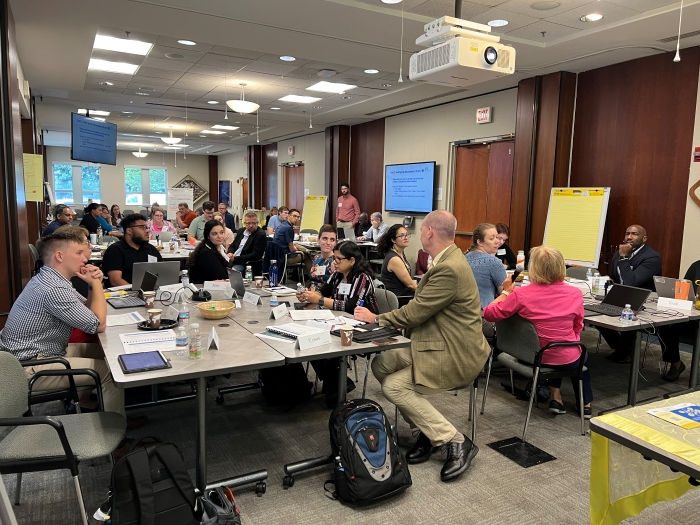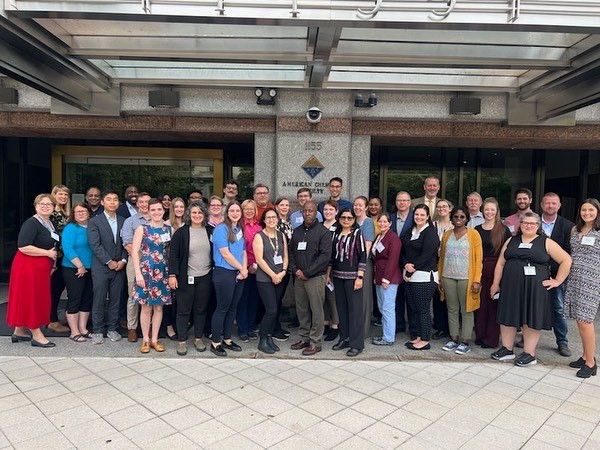Lab Safety Team (LST) leaders who organized and facilitated the 2023 ACS Presidential Lab Safety Teams Summit held in Washington DC. From left to right: Monica Nyansa, Caroline Donaghy, Daniel Hu, Brady Bresnahan, Amanda Chung.
When Monica Nyansa began her PhD at Michigan Technological University, she remembers being struck by a novelty of new hazards in her research lab. “At the PhD level, you have like a million different chemicals and different equipment,” she says. As a chemical biologist who works on organic synthesis, Nyansa was familiar with complicated equipment and hazardous chemicals. But this was a new project, in a new lab, with new hazards.
“There's only so much you can do on Google,” Nyansa says. A semester-long safety course helped a bit, but not enough. Her lab’s procedures weren’t ideal: she was responsible for discarding waste without knowing about the hazards inside; she encountered unfamiliar equipment, dozens of unfamiliar chemicals filled the shelves, and she struggled to make sense of the chemical safety information that was available. “I quickly realized that I wasn't really equipped to work in the lab as safely as I needed to.”
Nyansa didn’t know where to turn. “How do you deal with waste? Are we even storing the chemicals the right way?” she recalls wondering. Environmental health and safety (EHS) staff were helpful, but the fifth-year lab mate who knew the most about the lab’s hazards was about to graduate. She knew that she’d soon take on a lot of responsibility and that she needed answers. “I didn't have that community or support to fall back on as a first-year student,” she says.
Then, in November 2020, she attended an ACS workshop about lab safety teams. Laboratory safety teams (LSTs) are student-led grassroots groups that promote safety culture in their labs, departments, and institutions. They identify safety concerns, then come up with solutions to address them. The workshop reassured Nyansa that her concerns were valid. “I wasn't just going out of my mind. It did seem like a bigger problem,” she says.

Safety is paramount in labs of every kind. Graduate researchers, undergraduates, and some high school students work with corrosive, flammable, and toxic compounds. The procedures that labs use to manage the risks can vary widely, even between labs with the same hazards. According to a national survey published in 2016, 90% of respondents from academic labs “felt safe.” However, their other responses told a different story: 45% had injured themselves, 71% had witnessed minor injuries, and 30% had witnessed major injuries.
Inadequate training often plays a major role in lab accidents. And high turnover in academia makes it harder to pass down best practices. Combine these difficulties with the lack of standardization among faculty and universities, and it becomes easier to appreciate lab safety as a deeper challenge of safety culture.
“Your PI sets the tone for what you consider important during those years,” says Jessica Martin, a senior product manager with ACS Publications who led LST workshops after discovering the movement as a graduate student at the University of Connecticut (UConn). When PI’s don’t nurture safety culture, newcomers won’t be as proactive. “The lab right next door could have a PI with a completely different attitude, and it has no effect on your life whatsoever.”
LSTs don’t replace faculty safety training or EHS responsibilities—they complement and collaborate with both. Currently, there are more than 20 LSTs across 15 states.
In the decade since the first LST, the initiative has helped students develop skills in safety and leadership. The students and staff involved with LSTs believe the work is just beginning. A nationwide shift in academic lab safety culture may be on the way.
The origin story
LSTs began at the University of Minnesota in 2012, in partnership with Dow Chemical. Lab safety officers were points of contact for each research lab in chemistry, chemical engineering, and materials science. But resources were limited and roles were unclear. At the same time, Dow noticed gaps in safety skills among their new hires from the departments. “Industry employees noted that freshly graduated new hires can require as much as a year of safety training before being considered ‘safe’ to work in their R&D laboratories,” says Marta Gmurczyk, senior portfolio manager with ACS Safety Programs.
Gmurczyk adds that an industry rep once noted, “Industrial members have to assume that a new Ph.D. generally represents a safety risk to themselves, to their co-workers, and to the company and need a lot of training and supervision before they can be trusted to value safety.”
University of Minnesota’s first LST (or JST, joint safety team included seven graduate students, faculty, and a couple of industry representatives. The team assessed safety practices and attitudes. Their committees focused on compliance—such as ensuring proper signage in labs and following waste regulation protocols—and events to train safety officers. “It's grown from there,” says Brady Bresnahan, current co-president of the LST and a materials science and engineering graduate student at Minnesota, “with new initiatives, newer committees, as well as spreading to other institutions who have now had well established LSTs for 5 or more years.”
In the US, lab safety teams have evolved to reduce safety incidents through three main objectives:
|
What lab safety teams do
Many institutions form LSTs after their students, like Nyansa, attend an LST workshop. The workshops bring together researchers with vastly distinct perspectives. Martin notes: “People come in because they have these great experiences and really want to share them. And others come in because they’re having terrible experiences and feeling very alone, very isolated, and like no one was listening to them.”
Nyansa co-founded an LST at Michigan Tech the spring after her first workshop. The group holds elections every 6 months because of turnover from graduations. Nyansa became president in 2022. Her department was very supportive. “They gave us a platform to present what we've learned,” she says. “They were like, go for it. That really helped to bring graduate students within the department.”
The new organization held monthly meetings to share observations and ask questions about lab safety and to hold events like fire extinguisher training. “That's a big thing. How do you have students working with really flammable and pyrophoric chemicals, and they don't know anything about fire safety?” she asks.
LSTs usually enjoy good relationships with EHS staff at the university. Some members participate in EHS training sessions and adapt procedures for grad students. This helps standardize grad student safety training in ways that operations manuals and Google can’t. And that unified front comes in handy. LSTs teach how to thoroughly evaluate EHS compliance—in their labs and other labs as well.
Informal “peer to peer” inspections are valuable to supplement annual EHS inspections, says Bresnahan. “Everybody learns different safety aspects and strategies in a more friendly, casual way,” he adds.
Bresnahan’s LST developed a rubric containing about 15 safety items to evaluate how safe a lab is on a scale from 1 to 5. It standardizes how a perfect “5” looks and what deserves a 4, 3, 2, or 1.
Those skills enable more effective outreach, too. An LST can hold workshops for high school chemistry teachers and primarily undergraduate institutions, sharing strategies for lab safety, chemical hazards, and waste management. “A lot of them are facing the same challenges that our student leaders were facing before,” Bresnahan says. They sometimes feel they’ve been thrown into the deep end, facing cabinets full of unfamiliar chemicals older than themselves.
Companies regularly host industry lab tours for LSTs. The tours are eye-opening for some students who don’t work in labs with rigorous safety culture. Nobody enters without eye protection and a lab coat; labs are more secure; lab benches look organized; fume hoods are spotless. Detailed safety reviews of chemicals and procedures are common. “They really take it seriously,” Martin says. “This is the norm.”
About half of chemists go into industry after earning their doctorate, so the tours show students how they need to up their safety game. “In industry when an incident happens, they pay a lot harder for it,” Martin says. “Something may be perfectly fine with your PI, but do you really want to get fired in the first 6 months out of school because you couldn't follow basic directions?”
Though most LST funding comes from individual departments, not industry, ACS supports the programs in a variety of ways. “ACS wants to be a transformative force in advancing and promoting chemical safety in all laboratories where chemicals are used,” says Rachel Bocwinski, a safety program specialist with the ACS Office of Safety Programs. “LSTs play a vital role in this effort.”
LST workshops get support from the ACS Office of Safety Programs, the Division of Chemical Health and Safety (CHAS), and the Committee on Chemical Safety (CCS). In October 2023, CCS partnered with the Office of Safety Programs on the ACS Presidential Lab Safety Summit that brought LST grad student leaders to DC for the first time. CHAS developed a program called LST Quick Connections, an opportunity for LST members to engage with each other on relevant safety issues three times per year.
2023 Safety SummitLearn about the 2023 ACS Presidential LST Safety Summit Lab Safety TeamsExplore the new LST Directory & learn about student-led Lab Safety Teams |
“ACS has this thing that I like to call the ‘avalanche effect, says Caroline Donaghy, a chemistry PhD student at UConn. “Once you get involved with one thing, they continue reaching out to you and the opportunities just grow from there.”

Seeing results
The more an LST grows membership and recognition, the more it shapes a department’s safety culture. “A good indicator of positive safety culture is people are more willing to admit to those mistakes, rather than sweep it under the rug,” Bresnahan says. A positive safety culture encourages students to discuss and learn from “near miss” incidents.
Nyansa adds that one metric speaks volumes: “The group still exists,” she says. In 2021, Nyansa started an annual Lab Safety Day. Labs dedicate half the day to cleaning, then come together for lunch and a seminar.
But simply establishing an LST doesn’t guarantee results. New organizations must make a compelling case to be heard. That’s tough. “We floundered for a while,” says Martin, who built the UConn safety team after a 2018 workshop. “We had really good reception from the chemical safety specialists.”
The LST initiative has empowered students to take charge of their own safety, that of their lab mates, and peers—and to start a dialogue that might not have happened otherwise. Because safety professionals, faculty, and administrators show up too, students can see disagreements and conflict over best practices. According to Martin, that’s an essential lesson: “It’s a confusing and messy place,” she says. “What's great about having those people in the room is that you're hearing how much conflict there is in the space. Safety isn't done—there's a lot of discussion about how to do this better.”



